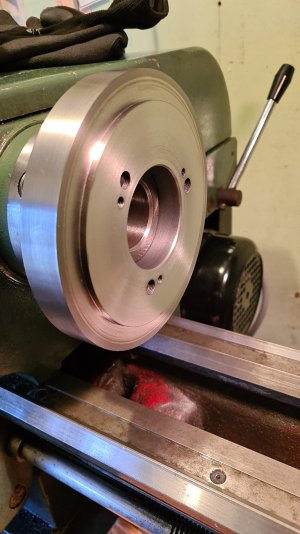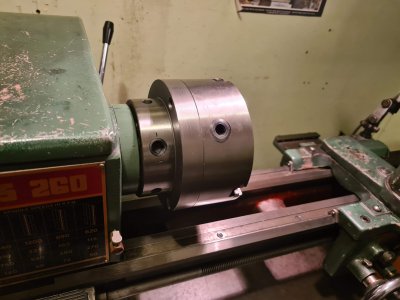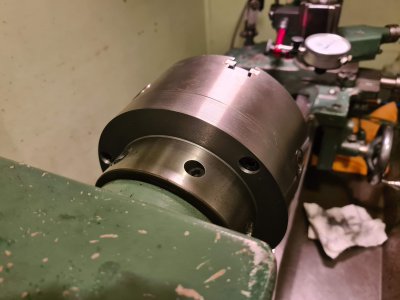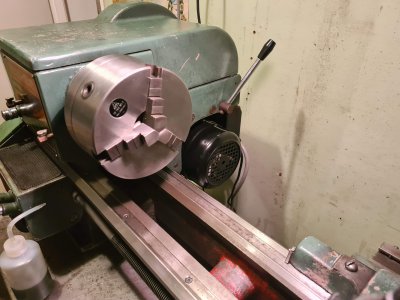-
Welcome back Guest! Did you know you can mentor other members here at H-M? If not, please check out our Relaunch of Hobby Machinist Mentoring Program!
You are using an out of date browser. It may not display this or other websites correctly.
You should upgrade or use an alternative browser.
You should upgrade or use an alternative browser.
TOS 3 jaw chuck
- Thread starter Boris Ludwig
- Start date
I vote for trying the chuck first like DZ suggested. You can make it a tap-tru at anytime later should the need arise. Bear in mind that independant jaw chucks are better suited to dialing in work than a scroll chuck with set-tru.
The idea of making it a tap-tru would automatically apply if you overshoot the dimensions when cutting the taper. But it is an option that is not reversible and maybe not the most practical.
The idea of making it a tap-tru would automatically apply if you overshoot the dimensions when cutting the taper. But it is an option that is not reversible and maybe not the most practical.
Last edited:
- Joined
- Oct 30, 2016
- Messages
- 155
Next question: I don't have a mill or a DRO. But I do have a drill press. To find the position of the three holes on the backplate I'm thinking I'd use a set of calipers and measure/mark the position around from hole to hole. Is this the best way to do this or is there some practical machinist trick I don't know about that makes it simpler and more accurate?
- Joined
- Nov 27, 2012
- Messages
- 7,856
Drill press is fine, the holes don't need to be precisionly located. Using dividers is fine too. I'm not sure if your chuck is a front or rear mount (mounting screws). If front mount you could use a transfer punch. I'm assuming it's a plain back chuck that's rear mount. In that case transfer screws would be a good method. Can also make them yourself.
In this case I personally would make the backplate register a close fit, or fairly close fit, make your mounting holes, then turn down for "tap-tru".
In this case I personally would make the backplate register a close fit, or fairly close fit, make your mounting holes, then turn down for "tap-tru".
- Joined
- Oct 30, 2016
- Messages
- 155
Drill press is fine, the holes don't need to be precisionly located. Using dividers is fine too. I'm not sure if your chuck is a front or rear mount (mounting screws). If front mount you could use a transfer punch. I'm assuming it's a plain back chuck that's rear mount. In that case transfer screws would be a good method. Can also make them yourself.
In this case I personally would make the backplate register a close fit, or fairly close fit, make your mounting holes, then turn down for "tap-tru".
Mounting holes are blind from the back. the Screws are M8 - 1.25 socket cap screws.
What are transfer screws?
- Joined
- Oct 30, 2016
- Messages
- 155
Never mind, I just found some on the net
- Joined
- Nov 27, 2012
- Messages
- 7,856
Transfer screw are like set screws which have points on them. You screw them into the blind holes with the points slight protruding. Then place the back plate on & tap the backplate (or chuck) lightly with a mallet so that the transfew screws will transfer punch marks onto the back plate.
If you search YT there are videos showing how to make them if you don't want to purchase them.
If you search YT there are videos showing how to make them if you don't want to purchase them.
- Joined
- Dec 20, 2012
- Messages
- 9,422
I recommend you use transfer punches or transfer screws, depending on if the the bolts attach from the chuck side or plate side.
Will and I were answering you at the same time. I'll elaborate.
Assuming your chuck bolts from the chuck side with bolts and also assuming you machine the back plate spigot for a loose fit, I would put a paper shim around the spigot and fit that into the chuck recess. That will center the chuck in the hole. Then I would clamp the backing plate to the chuck and use a transfer punch to mark one single hole. Then I would remove the chuck, spot drill that hole and tap it for the bolt. Then I would rejoin the plate and chuck and lock down that bolt you just tapped for and then clamp the plate and chuck again. This assures that nothing can move. Use the transfer punch to mark for the remaining two screws, then spot, drill and tap them.
I would recommend you NOT use calipers to mark holes; it is not accurate enough - been there, done that. I also do not recommend you mark all three holes at once; mark one, clamp everything down firmly and then mark for the remaining two holes.
EDIT: I was just about to post my reply and saw that your bolts will pass through the back plate and into the chuck. In that case, use transfer screws instead of punches. The procedure is the same except that again, mark for one screw and drill the hole. Then insert the transfer screws for the other two holes so that their points just project above the surace. Bolt the plate and chuck together and snug the bolt down, then gently clamp the plate to the chuck and tap over the transfer screws with a dead blow or a regular hammer with a block of wood laid down on the plate. This marks your two holes and you can drill them and you're done.
Will and I were answering you at the same time. I'll elaborate.
Assuming your chuck bolts from the chuck side with bolts and also assuming you machine the back plate spigot for a loose fit, I would put a paper shim around the spigot and fit that into the chuck recess. That will center the chuck in the hole. Then I would clamp the backing plate to the chuck and use a transfer punch to mark one single hole. Then I would remove the chuck, spot drill that hole and tap it for the bolt. Then I would rejoin the plate and chuck and lock down that bolt you just tapped for and then clamp the plate and chuck again. This assures that nothing can move. Use the transfer punch to mark for the remaining two screws, then spot, drill and tap them.
I would recommend you NOT use calipers to mark holes; it is not accurate enough - been there, done that. I also do not recommend you mark all three holes at once; mark one, clamp everything down firmly and then mark for the remaining two holes.
EDIT: I was just about to post my reply and saw that your bolts will pass through the back plate and into the chuck. In that case, use transfer screws instead of punches. The procedure is the same except that again, mark for one screw and drill the hole. Then insert the transfer screws for the other two holes so that their points just project above the surace. Bolt the plate and chuck together and snug the bolt down, then gently clamp the plate to the chuck and tap over the transfer screws with a dead blow or a regular hammer with a block of wood laid down on the plate. This marks your two holes and you can drill them and you're done.
- Joined
- Oct 30, 2016
- Messages
- 155
Ok, cool. Thanks for the details
- Joined
- Oct 30, 2016
- Messages
- 155






